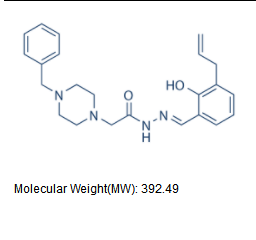Products
PAC-1 315183-21-2
| 1.Inquiries will be replied within 24 hours |
| 2.We could supply various packages as you required |
| 3.To protect the profit of our agents, price will not show on website, please send inquiries to get the price. |
| 4.Fast delivery, goods arrive your office within 3 to 5 days |
| 5.Please click "Inquiry" or "Email" below to get the price |
 |
|
|
||||||
|
C23H28N4O2 |
|
|||||
|
392.49 |
|
in stock | ||||
|
315183-21-2 |
|
98%+ |
Introduction
PAC-1 is a potent procaspase-3 activator with EC50 of 0.22 μM and the first small molecule known to directly activate procaspase-3 to caspase-3.
AC-1 activates procaspase-7 in a less efficient manner with EC50 of 4.5 μM. Elevated caspase 3 level in cancer cell lines allows PAC-1 to selectively induce apoptosis in a manner proportional to procaspase-3 concentration with IC50 of 0.35 μM for NCI-H226 cells to ~3.5 μM for UACC-62 cells. PAC-1 induces apoptosis in the primary cancerous cells with IC50 values of 3 nM to 1.41 μM, more potently than in the adjacent noncancerous cells with IC50 of 5.02 μM to 9.98 μM, which is also directly related to the distinct procaspase-3 concentration. PAC-1 activates procaspase-3 by chelating zinc ions, thus relieving the zinc-mediated inhibition and allowing procaspase-3 to auto-activate itself to caspase-3. PAC-1 is capable to induce cell death in Bax/Bak double-knockout cells and Bcl-2 and Bcl-xL-overexpressing cells with the same efficacy as its wild-type counterpart in a delayed manner. PAC-1 induces cytochrome c release in a caspase-3 independent manner, which subsequently triggers downstream caspase-3 activation and cell death. PAC-1 can not induce cell death and caspase-3 activation in Apaf-1 knockout cells, suggesting that apoptosome formation is essential for caspase-3 activation by PAC-1-mediated cell death.
Products for scientific research use only
AC-1 activates procaspase-7 in a less efficient manner with EC50 of 4.5 μM. Elevated caspase 3 level in cancer cell lines allows PAC-1 to selectively induce apoptosis in a manner proportional to procaspase-3 concentration with IC50 of 0.35 μM for NCI-H226 cells to ~3.5 μM for UACC-62 cells. PAC-1 induces apoptosis in the primary cancerous cells with IC50 values of 3 nM to 1.41 μM, more potently than in the adjacent noncancerous cells with IC50 of 5.02 μM to 9.98 μM, which is also directly related to the distinct procaspase-3 concentration. PAC-1 activates procaspase-3 by chelating zinc ions, thus relieving the zinc-mediated inhibition and allowing procaspase-3 to auto-activate itself to caspase-3. PAC-1 is capable to induce cell death in Bax/Bak double-knockout cells and Bcl-2 and Bcl-xL-overexpressing cells with the same efficacy as its wild-type counterpart in a delayed manner. PAC-1 induces cytochrome c release in a caspase-3 independent manner, which subsequently triggers downstream caspase-3 activation and cell death. PAC-1 can not induce cell death and caspase-3 activation in Apaf-1 knockout cells, suggesting that apoptosome formation is essential for caspase-3 activation by PAC-1-mediated cell death.
Products for scientific research use only






